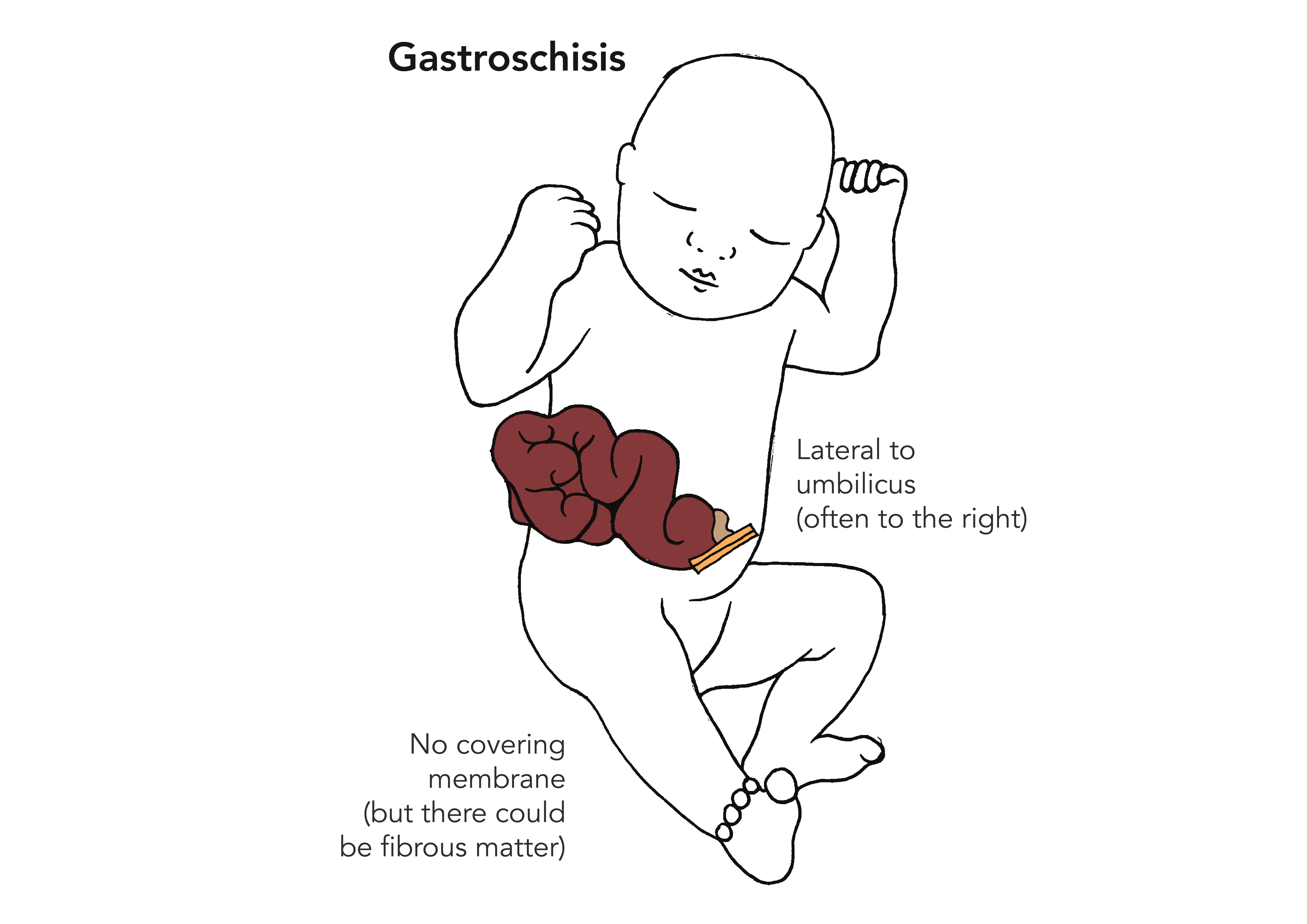Gastroschisis
Gastroschisis
What is gastroschisis?
Gastroschisis is a type of abdominal wall defect. In gastroschisis, the babies umbilical cord develops normally. However, to the side of this, the wall of the baby’s tummy (abdomen) does not form properly. This leads to the baby’s bowel and sometimes other organs such as the liver passing through this hole (defect) and floating in the amniotic fluid. This hole is most commonly to the right of the umbilical cord.

What causes gastroschisis?
Gastroschisis is a rare condition. Unfortunately, we do not know what causes it. It is not caused by something you have or have not done. Most babies with gastroschisis will not have any other structural problem or any genetic cause.
How do we find gastroschisis?
Most babies with gastroschisis are identified at the time of the early pregnancy (dating) ultrasound scan. It is also screened for at the 20-week ultrasound scan (between 18-20+6 weeks).
If gastroschisis is suspected, then you will be referred to a team of experts to help plan your care for this pregnancy (fetal medicine unit).
What tests and follow up will I be offered?
When you attend the fetal medicine unit, a specialist will ask you some questions about your pregnancy, any previous pregnancies, family history and your health. A second scan will be performed to confirm your baby has gastroschisis. The specialist will also have a detailed look at the baby to look for any other structural problems.
If your baby has another structural problem, then the specialist may discuss with you the options for testing the genetics of baby. Depending on how many weeks pregnant you are this can be through chorionic villous sampling (CVS) or amniocentesis (see links). Some families may decide to not continue with the pregnancy and opt for a termination of pregnancy. This will also be discussed as an option with you.
During your pregnancy you will have regular ultrasound scans to monitor the gastroschisis and baby’s growth. Babies with gastroschisis may be smaller, have less fluid around them or develop problems with their bowel such as a blockage. They are also more likely to be born early. We will plan for you to deliver your baby at St Michael’s Hospital, Bristol so that doctors with expertise in looking after babies with gastroschisis are present. We will generally recommend inducing your labour before your due date, around 37-38 weeks if there are no other complications. It is safe for most women to aim for a vaginal delivery.
What is the treatment for gastroschisis?
A specialist baby doctor (neonatologist) will be present at the time of the delivery of your baby. The baby will be cared for in the neonatal unit (NICU) after delivery. Your baby will have a line placed in their arm or through their umbilical cord to allow blood tests to be performed and to keep your baby hydrated. A tube will be placed through your baby’s nose down to their stomach (nasogastric or NG tube). Some babies may also require some support with their breathing. Your baby’s bowel will be covered in a bag or cling film. Your baby will also be started on antibiotics to reduce the risk of infection.
A specialist surgeon will assess your baby and discuss with you the options for treatment. Most babies with gastroschisis will have one of two treatments:
- An operation in the first few days of life to place the bowel back inside the baby’s tummy and close the defect. Operations are performed with the baby asleep (under general anaesthetic).
- A silo (like a plastic bag) is placed over the bowel whilst staying in NICU. This allows a gradual movement of the bowel back inside the baby’s tummy. This generally takes around 5 days, after which the defect can be closed with stitches or a dressing.
Around 1 in 10 babies with gastroschisis have an associated blockage in their bowel, called an atresia. This may only become obvious several weeks after the gastroschisis has been closed and will need further surgery.
Very rarely babies who are diagnosed during your pregnancy with gastroschisis are born with no defect and no bowel on the outside of their body. This means that the defect closed before they were born and that they will have lost some of their bowel. These babies usually need an operation to join the remaining bowel back together.
After the operation, your baby will closely monitored in NICU or on the surgical ward. Your baby will need feeding support through the line into their vein whilst their bowel starts to work. Feeding will then gradually commence with breast or bottle milk through their NG tube. Sometimes it can take many weeks before the bowel starts working properly. Occasionally the bowel doesn’t work well enough to cope with all their feeds into their gut and they need ongoing nutrition into their veins for months. Babies with gastroschisis are also at an increased risk of an illness called necrotising enterocolitis (NEC). This is an infection of the bowel which is treated by resting the gut (not feeding into the stomach) and giving antibiotics.
Follow-up
Most children with gastroschisis and no other problems will grow up to live normal lives. Some children will need ongoing support with their feeding and are dependent on parenteral nutrition (PN – nutrition into their veins). Some babies develop a belly button hernia (umbilical hernia) that will need a further small operation to fix it when they are about 4 years old.
Choices and support
Having a child diagnosed with a congenital anomaly can be a scary and difficult experience. Please don’t hesitate to chat to your medical team or GP who can let you know about the support available for you and your family. Antenatal Results and Choices https://www.arc-uk.org
